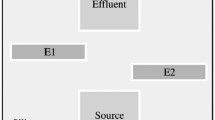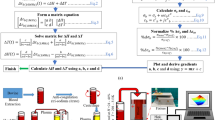Abstract
A study was designed to explore the possibility of detecting the haematocrit of blood by means of admittance measurements. The admittance and phase angle of blood kept in a measuring cell were determined at various frequencies between 60 kHz and 24 MHz. A reliable and accurate estimation of haematocrit was obtained in two ways. First, low-frequency admittance, high-frequency admittance and a factor x, which was the conductive percentage of cell content, were used. Secondly, the maximum phase angle was used. Both methods can be applied to obtain continuous on-line information about haematocrit for blood volume control during haemodialysis.
Similar content being viewed by others
References
Balme, L. andCavalcanti, A. C. (1983) Frequency of spectrum analysis of the complex bioelectrical impedance of blood. Proc. 6th Int. Conf. Electr. Bioimpedance. Zadar, Yugoslavia, 185–191.
Bonnie, E., Stiller, S. andMann, H. (1986) The influence of fluid overload on vascular refilling rate in hemodialysis: continuous online measurement with the conductivity method.Progr. in Artif. Organs,1985, 135–136.
Corten, P. M. J. (1980) Continuous registration of segmental stroke volume and wall movement of the left ventricle by means of electrical impedance measurements with an intraventricular multi-electrode catheter. Ph.D. thesis, University of Nijmegen, The Netherlands.
de Vries, P. M. J. M., Kouw, P. M., Meijer, J. H., Oe, P. L., Schneider, H. andDonker, A. J. M. (1988) Changes in blood parameters during hemodialysis as determined by conductivity measurements.Trans. Am. Soc. Artif. Intern. Organs,34, 623–626.
de Vries, P. M. J. M. (1989) Determination of intracellular and extracellular fluid volume by means of non-invasive conductivity measurements. Method,in vitro validation and clinical application during haemodialysis and haemofiltration. Ph.D. thesis, Free University Press, Amsterdam, The Netherlands.
de Vries, P. M. J. M. (1992) Plasma volume changes during hemodialysis.Seminars in Dialysis,5, 42–47.
Greenwood, R. N., Aldridge, C. andCattel, W. R. (1984) Serial blood water estimations and inline blood viscosimetry: the continuous measurement of blood volume during dialysis.Clin. Sci,66, 575–583.
Guyton, A. C. (1986)Textbook of medical physiology, 7th edn. Saunders, London.
Hanai, T. (1968) Electrical properties of emulsions. InEmulsion science.Sherman Ph. (Ed.), Academic Press, London, 354–477.
Kanai, H., Haeno, M. andSakamoto, K. (1982) Electrical measurement fluid distribution in legs and arms: estimation of extracellular and intracellular fluid. Proc. IEEE Conf. Frontiers of Eng. in Health Care, 1982, 273–276.
Kenner, T., Hinghofer, H., Leopold, H. andPogglitsch, H. (1977) Das Verhalten der Blutdichte in Relation zum Blutdruck im Tierversuch und bei der Hamodialyse von Patienten.Z. Kardiol.,66, 399–401.
Kim, K. E., Neff, M., Cohen, B., Sommerstein, M., Chinitz, J., Onesti, G. andSwartz, C. (1970) Blood volume changes and hypotension during haemodialysis.Trans. Am. Soc. Artif. Intern. Organs. 16, 508–514.
Meijer, J. H., de Vries, P. M. J. M., Goovaerts, H. G., Oe, P. L., Donker, A. J. M. andSchneider, H. (1989) Measurement of transcellular fluid shift during hemodialysis. Part 1 Method.Med. & Biol. Eng. & Comput.,27, 147–151.
Peura, R. A., Penney, B. C., Arcuri, J., Anderson, F. A. Jr. andWheeler, H. B. (1978) Influence of erythrocyte velocity on impedance plethysmographic measurements.,16, 147–154.
Roulet, C. andKawakami, K. (1983) Estimation of the intracellular content by electrical impedance. Proc. 6th Int. Conf. Electr. Bio-impedance. Zadar, Yugoslavia, 255–258.
Schneditz, D. andKenner, T. (1989) A sound-speed sensor for the measurement of total protein concentration in disposable, blood-perfused tubes.J. Acoust. Soc. Am.,86, 2073–2080.
Tedner, B. andLins, L. E. (1984) Fluid volume monitoring with electrical impedance technique during hemodialysis.Artif. Organs,8, 66–71.
Visser, K. R., Lambert, R., Korsten, H. H. andZijlstra, W. G. (1976) Observations on blood flow related electrical impedance changes in rigid tubes.Pflügers Arch.,366, 289–291.
Zheng, E., Shao, S. andWebster, J. G. (1984) Impedance of skeletal muscle from 1 Hz to 1 MHz.IEEE Trans.,BME-31, 477–481.
Author information
Authors and Affiliations
Rights and permissions
About this article
Cite this article
de Vries, P.M.J.M., Langendijk, J.W.G., Kouw, P.M. et al. Implications of the dielectrical behaviour of human blood for continuous online measurement of haematocrit. Med. Biol. Eng. Comput. 31, 445–448 (1993). https://doi.org/10.1007/BF02441978
Received:
Issue Date:
DOI: https://doi.org/10.1007/BF02441978




